Introduction and Package
Introduction
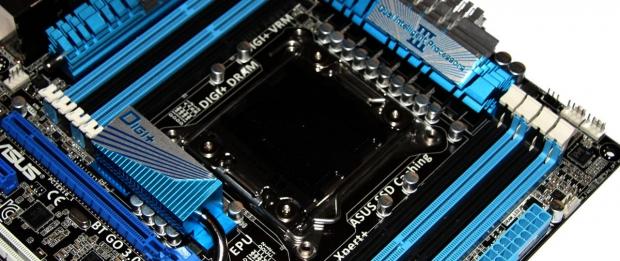
If you're going down the path of building an absolute beast of a system between now and Christmas, the chances are you're going to be looking at the X79 chipset and the new LGA 2011 CPUs from Intel. At launch we've seen so many motherboards from companies that offer so many different features and hit us at so many different price points.
With such a huge list of boards available at launch, we need to take some time and see what they're all about and we've already had a look at some absolutely awesome boards. The ASUS Rampage IV Extreme is an absolute beast and offered us huge overclocking and just a massive amount of features. Along with that we also checked out the GIGABYTE G1.Assassin2 and MSI X79A-GD65.
Today is all about the ASUS P9X79 Deluxe which is a board we actually previewed the other week alongside the ASUS P9X79 Pro which we'll be looking at soon.
Like the other boards we've previewed, we weren't able to tell you everything about the boards in our original coverage, so what we'll be doing today is looking at the bundle inside the box which is something we haven't looked at yet and we'll also have a look at the PCIe speeds that are on offer from the board here today.
That really covers just about everything, so I think we can get into the package to see exactly what's going on before we take a closer look at the board itself, the bundle and then of course the overclocking capabilities of the board alongside the performance.
The Package


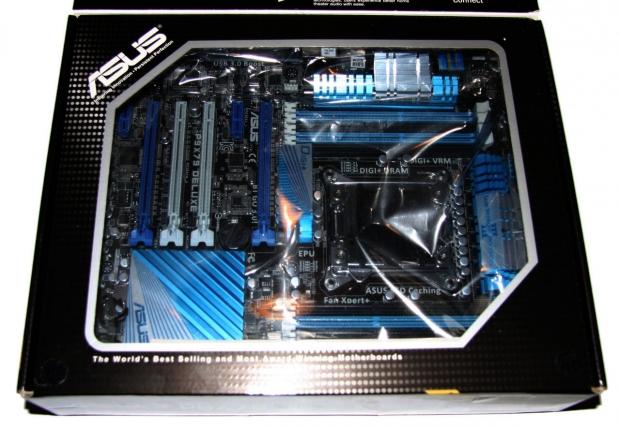
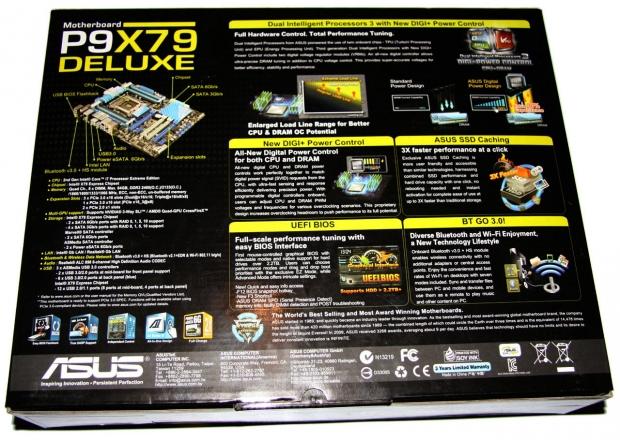
The box isn't anything we hadn't seen before, as we got a chance to look at it in our preview, so let's get into the bundle itself.


Moving inside the package, we've got a manual and driver CD along with eight SATA cables, EZ Connectors, 3-Way SLI bridge, longer CrossFire bridge and our rear I/O panel. Along with all that, we've also got a BT GO 3.0 adapter along with an antenna.
The Motherboard

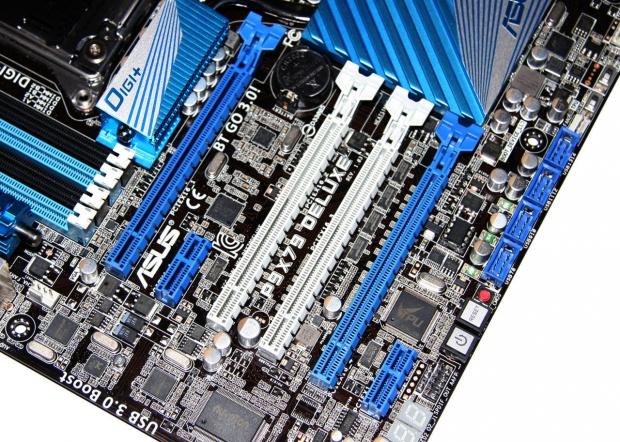


In our original preview we really covered everything above. With that said, we couldn't talk about the PCIe x16 slots and what they run at. Now we can and looking above, you can see we've got support for a three card setup along the four PCIe x16 slots.
If you're going for two cards, you'll use the two blue PCIe x16 slots and they will both run at x16. If you throw a third card into the mix and use the first white PCIe x16 slot then the setup will move to a x16 / x8 / x16 one.
The Motherboard Continued
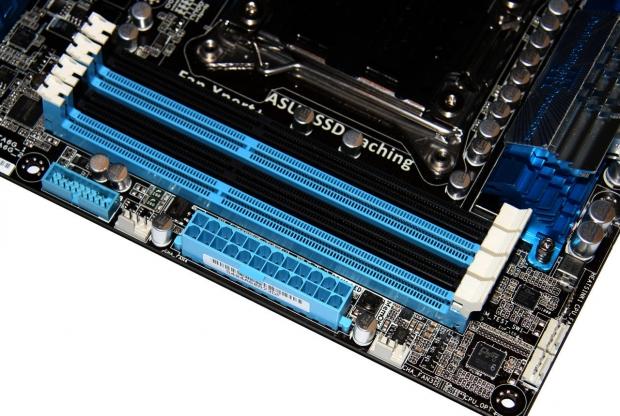

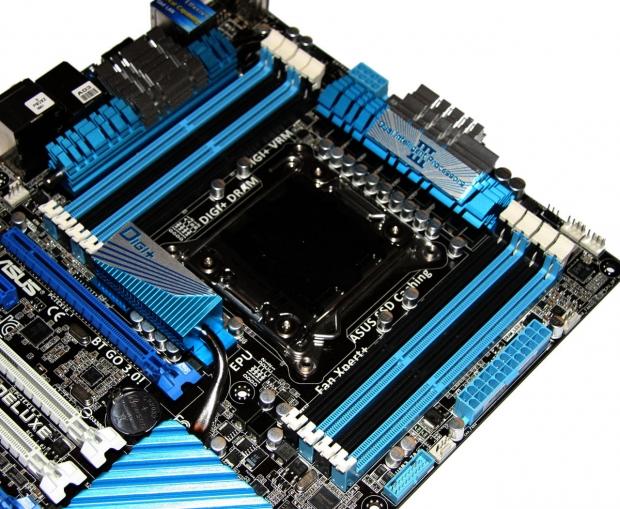

As for the rest of the board, we again covered pretty much everything; the only thing that we can say now that we couldn't before is the fact that the eight DIMM slots offer us Quad Channel support up to 2400MHz DDR and a total of 64GB across the eight slots.
BIOS
Firing up the BIOS, you're not going to see anything that you haven't seen out of other ASUS boards over the last six months, as they've really embraced the UEFI interface. Not being part of the ROG series means that when we get into the BIOS for the first time, we enter EZ Mode.

As usual, the options under EZ Mode are fairly basic and we get a good overview of everything that's going on. If we go up to the top right corner we can jump into Advanced Mode and again we'll be looking at fairly familiar territory.

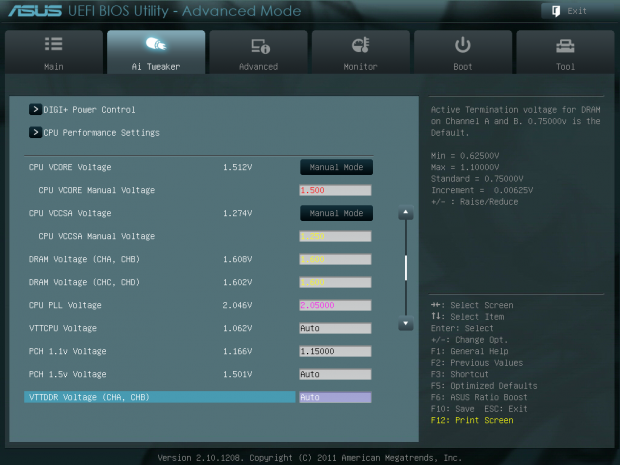


Looking above, you can see the BIOS in Advanced mode and if you're going to do anything on the overclocking side of things you'll want to of course be in the Ai Tweaker area. To get the maximum overclock you'll no doubt want to use a combination of the BCLK and the CPU Ratio that is under the CPU Performance setting.





Moving through the rest of the BIOS, there are no real surprises, so we'll get into the testbed side of things before we move onto the overclocking abilities on the board.
Test System Setup

We would like to thank the following companies for supplying and supporting us with our test system hardware and equipment: Intel, ASUS, MSI, Western Digital and Corsair.
On the testbed side of things there's not heaps that needs to be said as you can see our testbed above which gives us a good run down on what exactly is going on. Since there's not a lot that needs to be said in that department, let's get into the overclocking side of things.
Looking below, you can see our final overclock which comes in at 4874MHz or 4.87GHz as represented in our graphs here today. This was achieved by pushing our BCLK up to 125MHz and our multiplier to 39x.
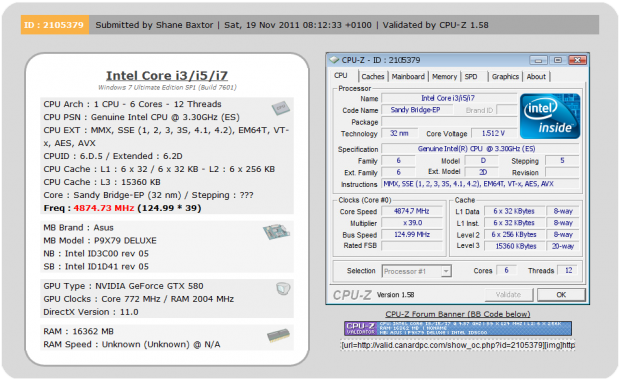
This is a really nice overclock and sits only a little lower than the Rampage IV Extreme which we saw come in at just over 5GHz. While we did manage to get into Windows at 5GHz via a 40x Multiplier and 125 BCLK, we actually got MediaEspresso up and running and I thought we were stable at this speed, but after about 4 minutes we ended with a BSOD.
Dropping the multiplier down just one notch, though, dropped our clock by only 125MHz as you can see, and it was the difference between the system being rock solid and unstable.
Before we get into the performance side of things, though, we'll just quickly cover the boards that are in our graphs today. We've got the higher end Rampage IV Extreme which we absolutely loved. We also have the MSI X79A-GD65, while we've got some Z68 representation via the Maximus IV Extreme-Z and the FX-8150 is here today via the ASRock Fatal1ty 990FX Professional.
Let's get started!
CPU Benchmarks
HyperPi 0.99
Version and / or Patch Used: 0.99
Developer Homepage: www.virgilioborges.com.br
Product Homepage: www.virgilioborges.com.br
HyperPi is a front end for SuperPi that allows for multiple concurrent instances of SuperPi to be run on each core recognized by the system. It is very dependent on CPU to memory to HDD speed. The faster these components, the faster it is able to figure out the number Pi to the selected length.
For our testing we use the 32M run. This means that each of the four physical and four logical cores for the i7 and the four physical cores of the i5 is trying to calculate the number Pi out to 32 million decimal places. Each "run" is a comparative to ensure accuracy and any stability or performance issues in the loop mentioned above will cause errors in calculation.
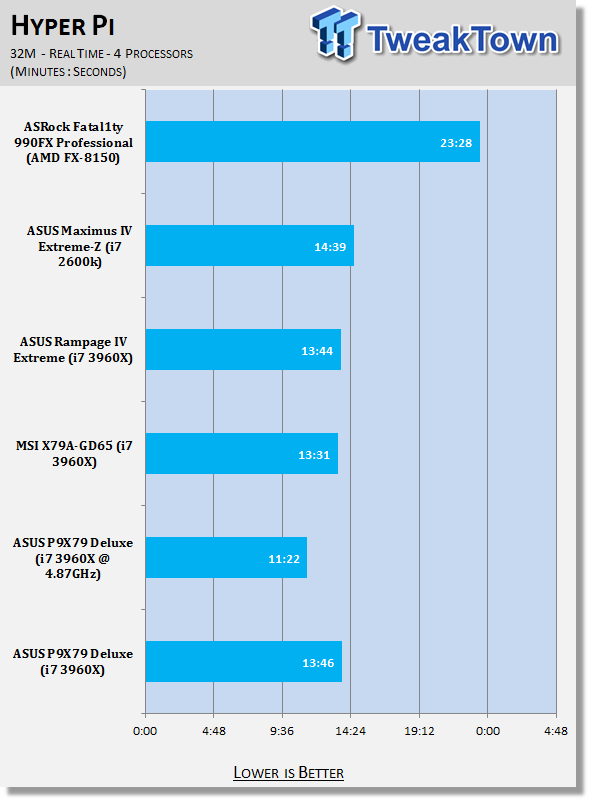
Looking at Hyper Pi, we can see that performance on our P9X79 Deluxe lines up with our other X79 motherboards. Overclocked, we can of course see that performance is strong with a nice chunk of time taken off the overall Hyper Pi run.
AIDA64
Version and / or Patch Used: 1.00.1035BETA
Developer Homepage: http://www.aida64.com
Product Homepage: http://www.AIDA64.com
Replacing Everest in our labs is AIDA64. This new testing suite is from the core development team from Lavalys and continues that tradition. The guys have thrown in better support for multithreaded CPUs as well as full 64 bit support. We use this to test memory and HDDs for now, but may find ourselves opening this up to other areas of the motherboard.
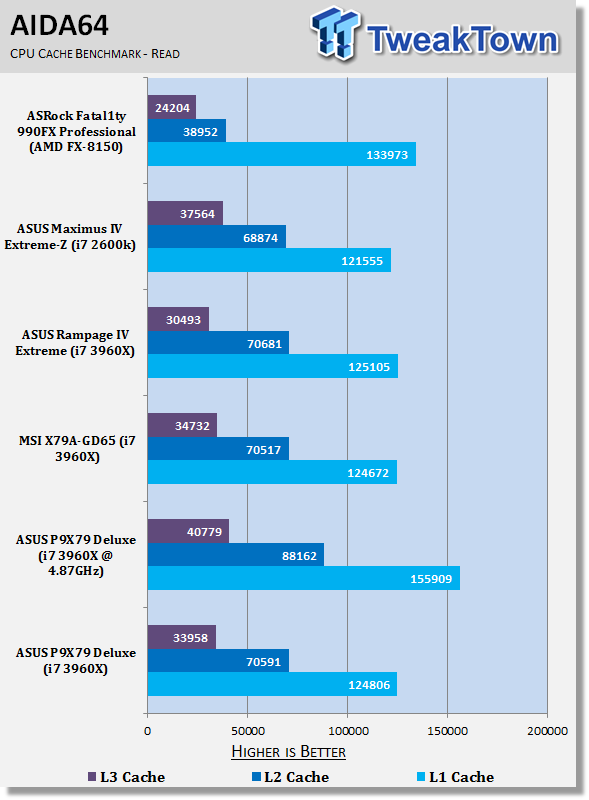

Looking at AIDA64 CPU performance, we can again see that at stock our performance lines up with our other X79 boards. Overclocked, though, we again see a nice boost in performance that shows us the power that's on offer from the new i7 3960X CPU.
System Benchmarks
PCMark 7
Version and / or Patch Used: 1.04
Developer Homepage: http://www.pcmark.com
Product Homepage: http://www.pcmark.com
PCMark 7 includes a range of tests that give different views of your system's performance. In the Advanced Edition you can choose which tests to run. The common use and hardware component tests are unavailable in the Basic Edition.
Overall system performance is measured by the PCMark test. This is the only test that returns an official PCMark score. The Lightweight test measures the system capabilities of entry-level systems and mobility platforms unable to run the PCMark test, but it does not generate a PCMark score. Common use performance is measured by the scenario tests - Entertainment, Creativity and Production - each of which results in a scenario score. Hardware component performance is measured by the hardware tests - Computation and Storage - each of which results in a hardware score.

Performance for PCMark 7 has been a bit wobbly since we started the new X79 platform. We can see some strong performance from our P9X79 Deluxe board here and a nice boost when we overclock. We're not putting lots of emphasis on this, though, not until we see performance even out a bit more.
MediaEspresso
Version and / or Patch Used: 6.5
Developer Homepage: http://www.cyberlink.com/
Product Homepage: http://www.cyberlink.com/products/mediaespresso/overview_en_AU.html?fileName=overview&r=1
MediaEspresso is a blazingly fast media universal converter that can transcode your videos, photos and music files and out put them to a huge range of portable devices including mobile phones, portable media players and even game consoles. With technologies like Smart Detect, Direct Sync and CyberLink's TrueTheater™ video enhancements, you can not only forget about complicated format, resolution and output settings, but your converted file will come out the other side looking better than when it went in!

Getting into MediaEspresso, we can see that our ASUS boards perform very close to each other. Overclocked, though, we see the power of the new CPU in a real world environment as we can convert a 4.3GB MKV down to an iPad 2 friendly format in 13 minutes.
USB 2.0 and 3.0 Benchmarks
AIDA64
Version and / or Patch Used: 1.70.1400
Developer Homepage: http://www.aida64.com
Product Homepage: http://www.AIDA64.com
Replacing Everest in our labs is AIDA64. This new testing suite is from the core development team from Lavalys and continues that tradition. The guys have thrown in better support for multithreaded CPUs as well as full 64 bit support. We use this to test memory and HDDs for now, but may find ourselves opening this up to other areas of the motherboard.


Turning on Turbo, we can see that USB 2.0 performance on the ASUS board is really strong like it was on the Rampage IV Extreme. Looking at USB 3.0 performance, though, we don't really see a difference. This is the same kind of picture we see from ASRock boards and XFast - USB 2.0 sees a nice boost while USB 3.0 doesn't really change.
SSD Benchmarks
AIDA64
Version and / or Patch Used: 1.70.1400
Developer Homepage: http://www.aida64.com
Product Homepage: http://www.AIDA64.com
Replacing Everest in our labs is AIDA64. This new testing suite is from the core development team from Lavalys and continues that tradition. The guys have thrown in better support for multithreaded CPUs as well as full 64 bit support. We use this to test memory and HDDs for now, but may find ourselves opening this up to other areas of the motherboard.

HD Tune Pro
Version and / or Patch Used: 4.61
Developer Homepage: http://www.hdtune.com
Product Homepage: http://www.hdtune.com
HD Tune Pro gives us accurate read, write and access time results and for the last couple of years has been gaining popularity amongst reviewers. It is now considered a must have application for storage device testing.

Looking at the performance of our SSD, we can see that performance is really strong and lines up with our Rampage IV Extreme in both our benchmarks.
Memory Benchmarks
AIDA64
Version and / or Patch Used: 1.00.1035BETA
Developer Homepage: http://www.aida64.com
Product Homepage: http://www.AIDA64.com
Replacing Everest in our labs is AIDA64. This new testing suite is from the core development team from Lavalys and continues that tradition. The guys have thrown in better support for multithreaded CPUs as well as full 64 bit support. We use this to test memory and HDDs for now, but may find ourselves opening this up to other areas of the motherboard.
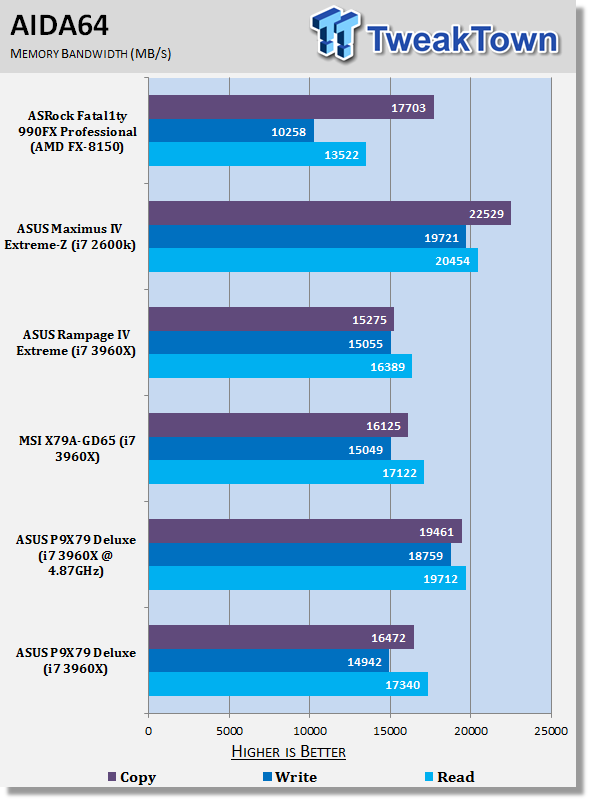
Heading back into AIDA64, we can check out our memory performance which lines up with our other X79 boards. If you're interested in learning a bit more about the testing of Quad Channel memory compared to Dual Channel, I'd recommend you read our Intel X79 Quad Channel and Z68 Dual Channel Memory Performance Analysis.
Gaming Benchmarks
3DMark 11
Version and / or Patch Used: 1.0
Developer Homepage: http://www.futuremark.com
Product Homepage: http://www.3dmark.com/3dmark11/
3DMark 11 is the latest version of the world's most popular benchmark. Designed to measure your PC's gaming performance 3DMark 11 makes extensive use of all the new features in DirectX 11 including tessellation, compute shaders and multi-threading. Trusted by gamers worldwide to give accurate and unbiased results, 3DMark 11 is the best way to consistently and reliably test DirectX 11 under game-like loads.

Metro 2033
Version and / or Patch Used: Latest Steam Update
Timedemo or Level Used: Built in Benchmark
Developer Homepage: http://www.4a-games.com//
Product Homepage: http://www.thqnordic.com/
Metro 2033 is an action-oriented video game with a combination of survival horror and first-person shooter elements. The game is based on the novel Metro 2033 by Russian author Dmitry Glukhovsky. It was developed by 4A Games in Ukraine and released in March 2010 for Microsoft Windows and Xbox 360.[3] In March 2006, 4A Games announced a partnership with Glukhovsky to collaborate on the game.[4] The game was announced at the 2009 Games Convention in Leipzig;[5] a first trailer came along with the announcement.[6] A sequel was announced, currently titled Metro: Last Light.

Looking at the gaming performance of the board, we haven't got anything out of the ordinary. We can see a bit of a boost in the Performance preset under 3DMark 11, but apart from that everything lines up just as we'd expect.
Temperature and Power
Power Draw Tests

Looking at the power draw side of things, we can see that the P9X79 Deluxe is drawing similar power numbers to the Rampage IV Extreme with both boards sitting higher than the MSI one. Overclocked we see those numbers blow out even more with an extra 100 Watt of power draw at load over stock.
Core Temperature

On the temperature side of things we can see that our stock numbers line up fairly close with each other, with the MSI one coming in a little cooler. Overclocked, though, we do of course see quite a jump in the heat.
Final Thoughts
The ASUS P9X79 Deluxe does a good job of ticking all the right boxes. Going over it, we've got good performance out of the box that's made better by a strong overclock. On the design side of things we've got a good layout - eight DIMM slots, support for three dual slot video cards and a really strong lineup of features.
Moving inside the box to look at the bundle, we've got everything needed to get up and running along with a few extras including the BT 3.0 header and an antenna to accompany it.
At $379.99 US it's one of the more expensive boards on the market and its biggest competition at this pricing level is probably the GIGABYTE G1.Assassin 2 which comes in just $20 US higher. Above that, the next option is the much more expensive Rampage IV Extreme at $469.99 US.
The P9X79 Deluxe is a really good option at the moment for people who are looking at going down the path of an ASUS board, want a strong feature set, good overclocking potential and a really nice bundle, but don't want to go quite to the extreme that the Rampage IV Extreme offers.
The board is just very typical ASUS, and really, if you've used ASUS boards you will know that's only a good thing. The UEFI BIOS is also one of the most refined on the market and while nowhere near as insane as the Rampage IV Extreme BIOS, there's an excellent amount of options that help offer us a really strong overclock.
If you're looking for a good well rounded board from ASUS and you really like the Black / Blue color scheme that's on offer from the Deluxe board, this is a really nice option. If you're happy to spend a bit more, you can always go down the path of the Rampage IV Extreme. If you want to save some money, the P9X79 Pro could be the board for you. That one we'll be looking at very soon to see what it offers.

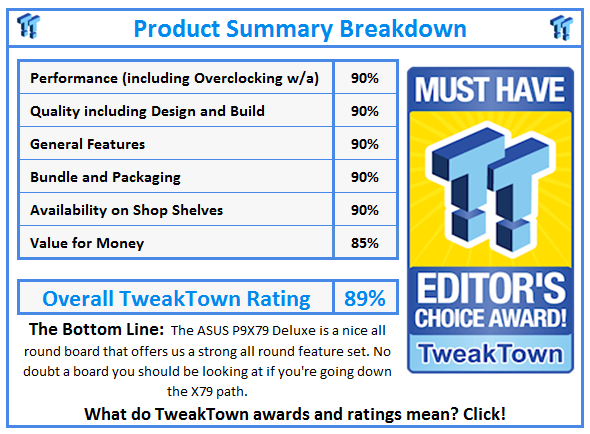
 United
States: Find other tech and computer products like this
over at
United
States: Find other tech and computer products like this
over at  United
Kingdom: Find other tech and computer products like this
over at
United
Kingdom: Find other tech and computer products like this
over at  Australia:
Find other tech and computer products like this over at
Australia:
Find other tech and computer products like this over at  Canada:
Find other tech and computer products like this over at
Canada:
Find other tech and computer products like this over at  Deutschland:
Finde andere Technik- und Computerprodukte wie dieses auf
Deutschland:
Finde andere Technik- und Computerprodukte wie dieses auf